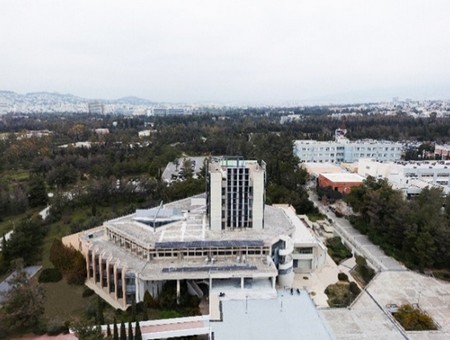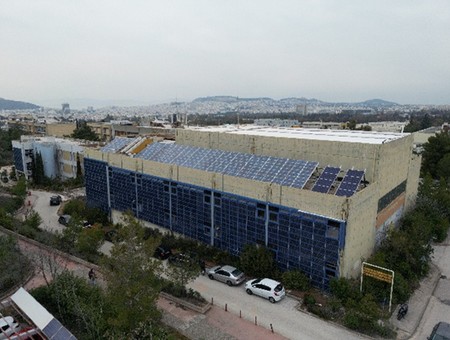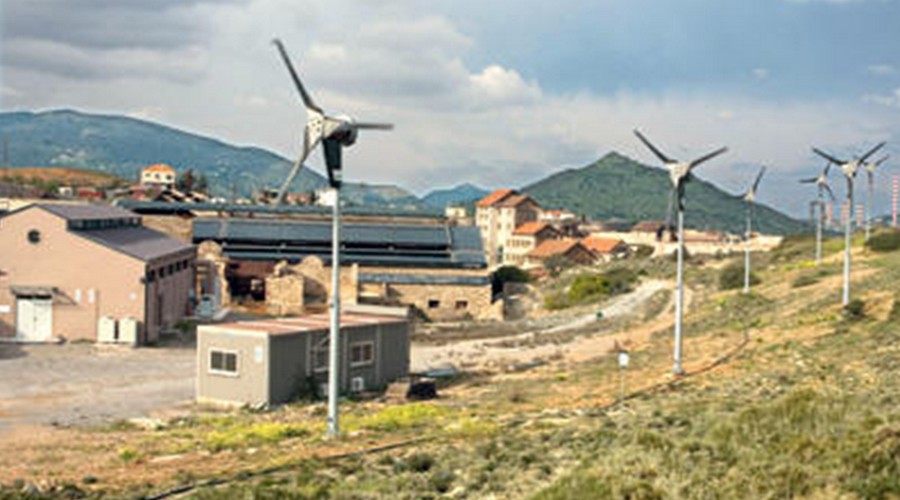Tactics to increase the use of renewables
The National Technical University of Athens has taken significant steps towards sustainability and the use of renewable energy sources in various university buildings. The following is a summary of the Renewable Energy Sources facilities at NTUA:
Especially:
A 20kW photovoltaic system has been installed on the south facade and roof of the building, offering a sustainable energy source for the library needs (Fig. 12(a)).
A 10kW photovoltaic system has been installed in the parking lot and enhances the energy self-sufficiency of the building.
In the Laboratory of Applied Thermodynamics, 5 Solar Cogeneration – PVT systems have been installed for simultaneous production of Heat and Electricity to supply an adsorption chiller, total generated electrical power and heat. Correspondingly, a 40 m² solar thermal field of vacuum collectors has been installed in the Steam Engine and Boiler Laboratory and supplies a solar cooling system with adsorption, covering the thermal needs of 5 offices of the Laboratory.
A 50kW photovoltaic system has been installed on the south facade of the building and contributes to reducing dependence on conventional energy sources (Fig. 12(b)).
There is a 15kW photovoltaic system on the roof that is under installation, as well as a geothermal system near the building that provides an alternative energy solution for heating and cooling.
The installation of 136 photovoltaic panels with a total power of 56kW has been completed, while a smaller photovoltaic system with a power of 2kW has already been installed on the roof of the Administration Building since the previous five years.

(a)

(b)
Fig. 12. Installation of photovoltaic systems (a) in the central library of the National Technical University of Athens and (b) in the School of Chemical Engineering
An important issue with renewables, such as solar and wind energy, is the given emphasis in energy production. To store the excess energy produced, an electrolysis unit was installed to produce hydrogen from the surplus electricity. Also, a fuel cell was installed, which will use the stored hydrogen to regenerate electricity, thus ensuring continuous and stable electricity production for the microgrid, which also supplies the NTUA’s computer center. Part of the hydrogen produced by electrolysis will also be used for the biological upgrade of biogas produced from food residues, in collaboration with the Municipality of Chalandri, offering an innovative solution for the production of biomethane, which is converted into bioCNG for the movement of vehicles.
At the Lavrio Technology Park (Fig. 13), the National Technical University of Athens (NTUA) is implementing a pioneering experiment that demonstrates the potential towards energy autonomy through scientific research and technological innovation. An old industrial building, formerly used to produce pasta, has been transformed into a modern office building with an area of 500 m².
This building has been equipped with 6 small wind turbines with a total power of 36 kW and photovoltaic panels with an area of 475 m² and a power of 47 kW. The energy produced is converted from direct to alternating current and is used to meet the needs of the building such as air conditioning and computer operation. The excess energy is stored as hydrogen through electrolysis, thus ensuring the possibility of a continuous energy supply during days of reduced production or increased demand.
In addition, the building has a hydrogen burner with a capacity of 90,000 kcal/h, which is used to heat water, helping to meet the building’s thermal needs during the winter months. All systems operate automatically and are coordinated through special control and monitoring software, which allow continuous monitoring and optimal energy management.

Fig. 13. Lavrion Technological and Cultural Park



